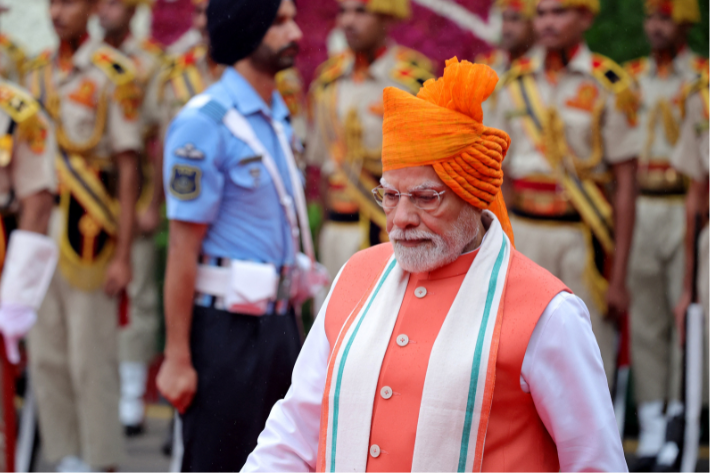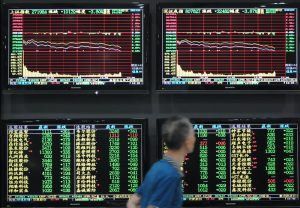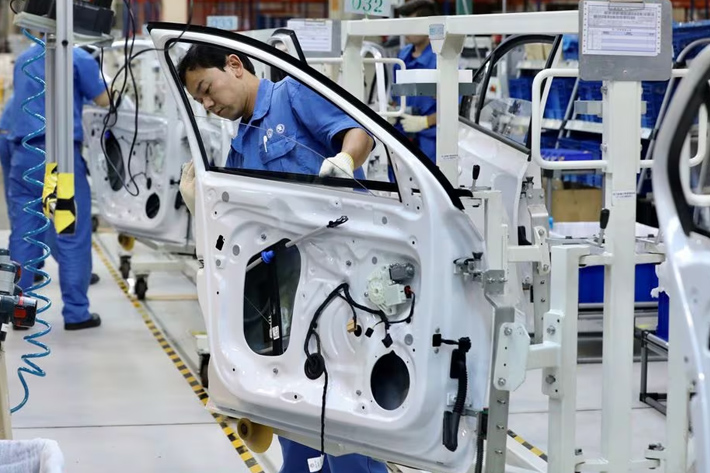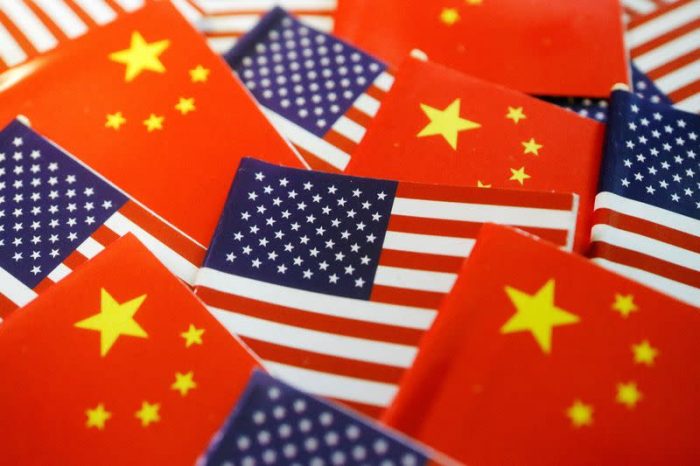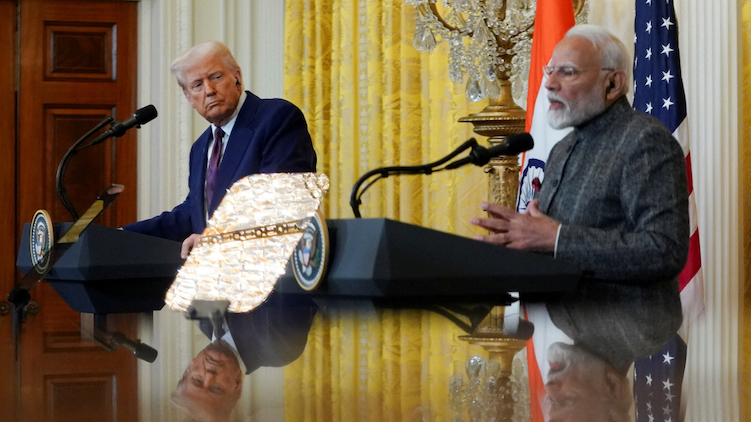Indian markets on Monday remained unfazed by reports of the United States ‘calling off’ trade deal negotiations with the Narendra Modi government as investor sentiment was lifted by the administration’s plan for a significant tax overhaul.
Indian benchmark shares jumped about 1%, with the Nifty 50 index posting its biggest single-day percentage gain since June 26, 2025.
The rally was brought on by Modi’s announcement on slashing the consumption tax India charges consumers and businesses by Diwali, the Hindu festival of lights, set to be celebrated in October this year. The promised cuts will be India’s biggest tax overhaul since 2017.
Also on AF: How Trump Lost The Plot, On India
Modi made his announcement while addressing the nation on its 79th independence day on Friday. Indian markets were closed that day.
An Indian government official later confirmed plans to slash that tax — also known as the goods and services tax. The GST cuts, along with income tax reductions announced in February, could mean policy stimulus of 0.7-0.8% of GDP to households, Citi Research said in a note on Monday.
The tax reforms gave a significant impetus to investor sentiment despite the drag of stalled trade negotiations with the United States. Multiple media reports said over the weekend that negotiations had been called off. A planned visit by US trade negotiators to New Delhi now stands deferred to another date that has yet to be decided, Reuters reported.
Meanwhile, newspaper Indian Express reported on Sunday citing a source familiar with the matter that the visit had been “halted” by the US “for now”. A day earlier, its sister-publication, the Financial Express, had quoted a source as saying that “from their (US) side, the trade negotiations (are) halted, whether (this is) forever or temporary, there’s still no idea.”
“They said they won’t come for the August 25 meeting.”
With talks now in limbo, many Indian goods headed to the United States will face an additional 25% tariff on top existing 25% levies. The additional tariffs mean India will face the highest levy along with Brazil, putting it at a significant disadvantage against regional competitors such as Vietnam and Bangladesh. Experts say the duties will have a major impact on India’s gems & jewellery sector.
Meanwhile, key segments like electronics and pharma will continue to be exempt from this additional rate.
Why are the GST cuts important?
The big boost to markets on Monday was widely expected considering India’s GST regime has been criticised as being too complicated and burdensome by consumers and businesses alike.
India launched the major tax system in 2017 that subsumed local state taxes into the new, nationwide GST to unify its economy for the first time. But the biggest tax reform since India’s independence faced criticism for its complex design that taxes products and services under four slabs – 5%, 12%, 18% and 28%.
For instance, last year, India said caramel popcorn would be taxed at 18% but the salted category at 5%.
Under the new system, India will abolish the 28% slab – which includes cars and electronics – and move nearly all of the items under the 12% category to the lower 5% slab, benefitting many more consumer items and packaged foods. The cuts will make daily essentials and electronics cheaper from October, helping consumers and also companies like Nestle, Samsung and LG Electronics.
“The GST reform plan should spur consumption and cushion GDP against external tariff risks,” said Narendra Solanki, Narendra Solanki, head of research at Anand Rathi.
“It’s a clear positive for consumption-driven stocks, durables, small cars, and two-wheelers, with ripple gains for consumer financiers and cement makers.”
Government data shows the 28% and 12% tax slabs together garner 16% of India’s annual GST revenue of roughly $250 billion last fiscal year. The GST reform will cost the state and federal government $20 billion annually, India’s IDFC First Bank said.
“But it will improve weak stock market sentiment,” Rasheed Kidwai, a fellow at New Delhi-based Observer Research Foundation told Reuters.
“GST reduction will impact everyone, unlike cuts to income tax, which is paid by only 3%-4% of the population. Modi is doing this as he is under a lot of pressure due to US policies,” said Kidwai.
“The move will also help the stock market, which is now politically important as it has a lot of retail investors.”
Indian indexes have underperformed global markets this year, with the Nifty up 5.2%, compared with gains of 17.4% in Asia and 18.3% in emerging markets.
India, world’s fifth largest economy is expected to grow at 6.5% in 2025, according to central bank estimates, but economists have pointed to sluggish urban consumption as wage growth remains modest.
What’s going on with India-US trade talks?
Trade talks between New Delhi and Washington collapsed after five rounds of negotiations over disagreement on opening India’s vast farm and dairy sectors and stopping Russian oil purchases.
India’s Foreign Ministry has said the country is being unfairly singled out for buying Russian oil while the United States and European Union continue to purchase goods from Russia.
And on Monday, after reports of it halting trade negotiations, the US continued to build up the pressure on India. White House trade adviser Peter Navarro said India’s purchases of Russian crude were funding Moscow’s war in Ukraine and had to stop, in an opinion piece published in the Financial Times on Monday.
“If India wants to be treated as a strategic partner of the US, it needs to start acting like one,” Navarro wrote.
“India acts as a global clearinghouse for Russian oil, converting embargoed crude into high-value exports while giving Moscow the dollars it needs,” he added.
The adviser also said India’s close ties with Russia and China made it risky to transfer cutting-edge US military capabilities to India.
The Indian government and the country’s refiners, meanwhile, have remained unfazed by US pressure. The country’s top refiner Indian Oil Corp said on Monday it will continue to buy Russian oil depending on economics.
Meanwhile, the country is also looking to shore up support for domestic manufacturers to manage the impact of new US levies. On Friday, after announcing the GST cuts, India’s Modi urged Indians to use more goods made domestically. Modi has previously also vowed to protect farmers, fishermen and cattlemen — a veiled reference to Trump’s demand of opening Indian agricultural and dairy markets to US exports.
India’s reluctance to do so — which it says is a ‘red line’ — has been a key reason behind Trump not moving forward with a near-final trade deal.
Still, S&P Global Ratings said last week that the effect of US tariffs on the Indian economy will be “manageable”, especially as “about 60 per cent of its economic growth stems from domestic consumption.”
Exporters in the country remain on edge, however, and some domestic analysts say the levies could put around 300,000 jobs at risk.
- Vishakha Saxena, with Reuters
Also read:
India Wants US Ties With Mutual Respect, Says Arms Deals Still On
Trump’s Tariffs Spur Calls to Boycott American Goods in India
Trump Ramps Criticism of India: ‘Backing ‘Russian War Machine’
India’s Modi Shows His Preference: a Free-Trade Pact With Britain
Trump Says India Will Face 25% Tariff, Penalty From August 1
India Now the Biggest Source of Smartphone Exports to the US
Trump’s Dealings With Pakistan Has India Slowing Tariff Talks
Can Trump Tariffs Deliver a Significant ‘Moment’ for Asia?




